NUR231 Case Study: Pathophysiology, Medications, and Patient Advice
VerifiedAdded on 2022/09/09
|7
|2541
|29
Case Study
AI Summary
This case study assignment, completed for NUR231, analyzes the case of a patient, Jolene, presenting with symptoms of tachycardia, angina, hypertension, anxiety, and tremor. The assignment explores the immediate actions required for assessment and monitoring of these signs and symptoms, delving into the pathophysiology of asthma, including the role of inflammatory cells and airway remodeling. It also provides details on medications such as Ventolin, Serevent, and Atrovent, explaining their indications and mechanisms of action. Furthermore, the case study addresses Graves' disease, its symptoms, and antithyroid drug treatments. It examines the rationale behind the combination of drug therapy, including LABAs, ICS, and bronchodilators, and their interactions. Finally, the assignment includes a simulated clinical conversation, offering advice to Jolene regarding her condition and drug therapy in relation to her pregnancy, emphasizing the importance of a balanced approach to treatment and lifestyle modifications while considering professional codes and standards.
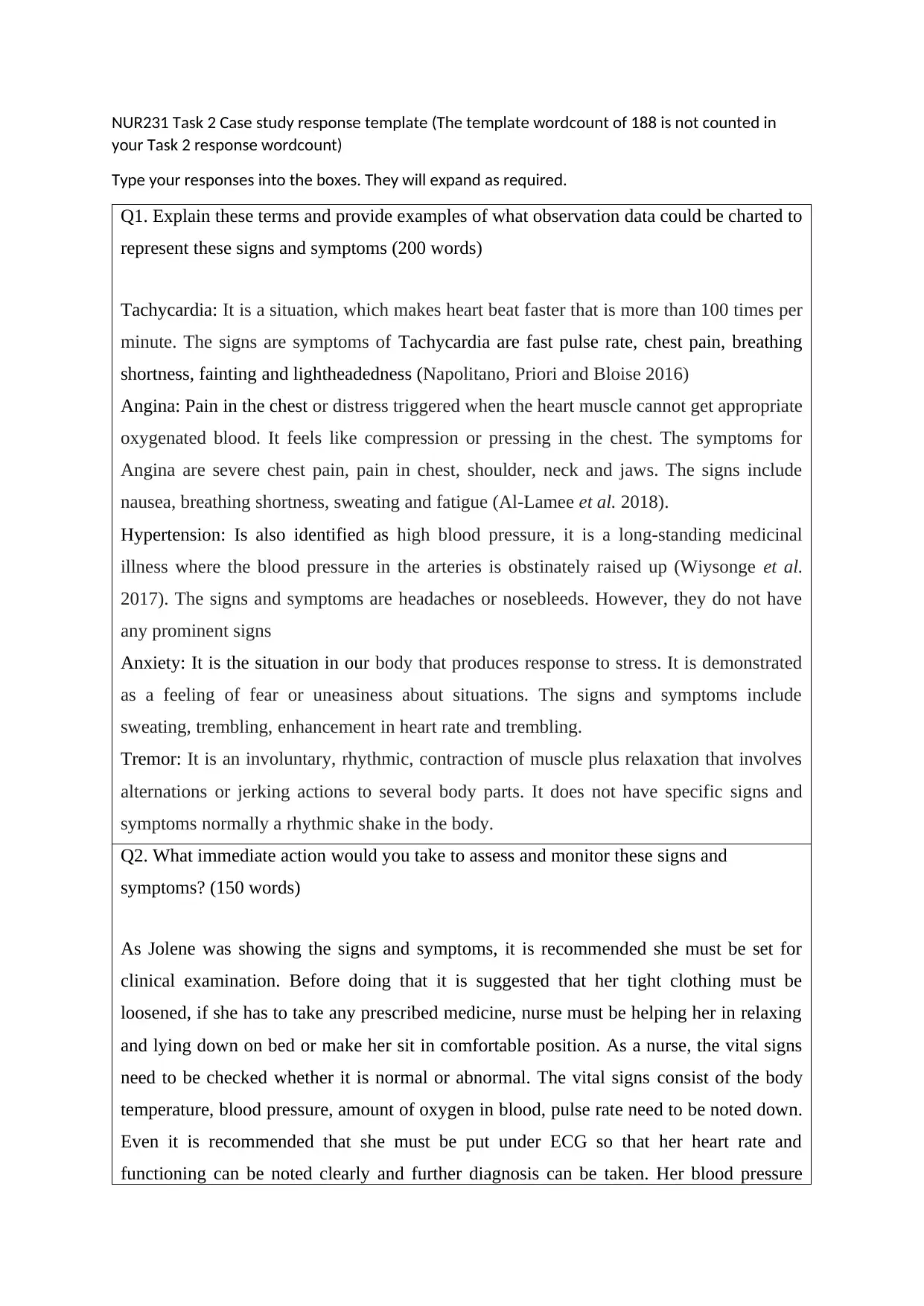
NUR231 Task 2 Case study response template (The template wordcount of 188 is not counted in
your Task 2 response wordcount)
Type your responses into the boxes. They will expand as required.
Q1. Explain these terms and provide examples of what observation data could be charted to
represent these signs and symptoms (200 words)
Tachycardia: It is a situation, which makes heart beat faster that is more than 100 times per
minute. The signs are symptoms of Tachycardia are fast pulse rate, chest pain, breathing
shortness, fainting and lightheadedness (Napolitano, Priori and Bloise 2016)
Angina: Pain in the chest or distress triggered when the heart muscle cannot get appropriate
oxygenated blood. It feels like compression or pressing in the chest. The symptoms for
Angina are severe chest pain, pain in chest, shoulder, neck and jaws. The signs include
nausea, breathing shortness, sweating and fatigue (Al-Lamee et al. 2018).
Hypertension: Is also identified as high blood pressure, it is a long-standing medicinal
illness where the blood pressure in the arteries is obstinately raised up (Wiysonge et al.
2017). The signs and symptoms are headaches or nosebleeds. However, they do not have
any prominent signs
Anxiety: It is the situation in our body that produces response to stress. It is demonstrated
as a feeling of fear or uneasiness about situations. The signs and symptoms include
sweating, trembling, enhancement in heart rate and trembling.
Tremor: It is an involuntary, rhythmic, contraction of muscle plus relaxation that involves
alternations or jerking actions to several body parts. It does not have specific signs and
symptoms normally a rhythmic shake in the body.
Q2. What immediate action would you take to assess and monitor these signs and
symptoms? (150 words)
As Jolene was showing the signs and symptoms, it is recommended she must be set for
clinical examination. Before doing that it is suggested that her tight clothing must be
loosened, if she has to take any prescribed medicine, nurse must be helping her in relaxing
and lying down on bed or make her sit in comfortable position. As a nurse, the vital signs
need to be checked whether it is normal or abnormal. The vital signs consist of the body
temperature, blood pressure, amount of oxygen in blood, pulse rate need to be noted down.
Even it is recommended that she must be put under ECG so that her heart rate and
functioning can be noted clearly and further diagnosis can be taken. Her blood pressure
your Task 2 response wordcount)
Type your responses into the boxes. They will expand as required.
Q1. Explain these terms and provide examples of what observation data could be charted to
represent these signs and symptoms (200 words)
Tachycardia: It is a situation, which makes heart beat faster that is more than 100 times per
minute. The signs are symptoms of Tachycardia are fast pulse rate, chest pain, breathing
shortness, fainting and lightheadedness (Napolitano, Priori and Bloise 2016)
Angina: Pain in the chest or distress triggered when the heart muscle cannot get appropriate
oxygenated blood. It feels like compression or pressing in the chest. The symptoms for
Angina are severe chest pain, pain in chest, shoulder, neck and jaws. The signs include
nausea, breathing shortness, sweating and fatigue (Al-Lamee et al. 2018).
Hypertension: Is also identified as high blood pressure, it is a long-standing medicinal
illness where the blood pressure in the arteries is obstinately raised up (Wiysonge et al.
2017). The signs and symptoms are headaches or nosebleeds. However, they do not have
any prominent signs
Anxiety: It is the situation in our body that produces response to stress. It is demonstrated
as a feeling of fear or uneasiness about situations. The signs and symptoms include
sweating, trembling, enhancement in heart rate and trembling.
Tremor: It is an involuntary, rhythmic, contraction of muscle plus relaxation that involves
alternations or jerking actions to several body parts. It does not have specific signs and
symptoms normally a rhythmic shake in the body.
Q2. What immediate action would you take to assess and monitor these signs and
symptoms? (150 words)
As Jolene was showing the signs and symptoms, it is recommended she must be set for
clinical examination. Before doing that it is suggested that her tight clothing must be
loosened, if she has to take any prescribed medicine, nurse must be helping her in relaxing
and lying down on bed or make her sit in comfortable position. As a nurse, the vital signs
need to be checked whether it is normal or abnormal. The vital signs consist of the body
temperature, blood pressure, amount of oxygen in blood, pulse rate need to be noted down.
Even it is recommended that she must be put under ECG so that her heart rate and
functioning can be noted clearly and further diagnosis can be taken. Her blood pressure
Paraphrase This Document
Need a fresh take? Get an instant paraphrase of this document with our AI Paraphraser
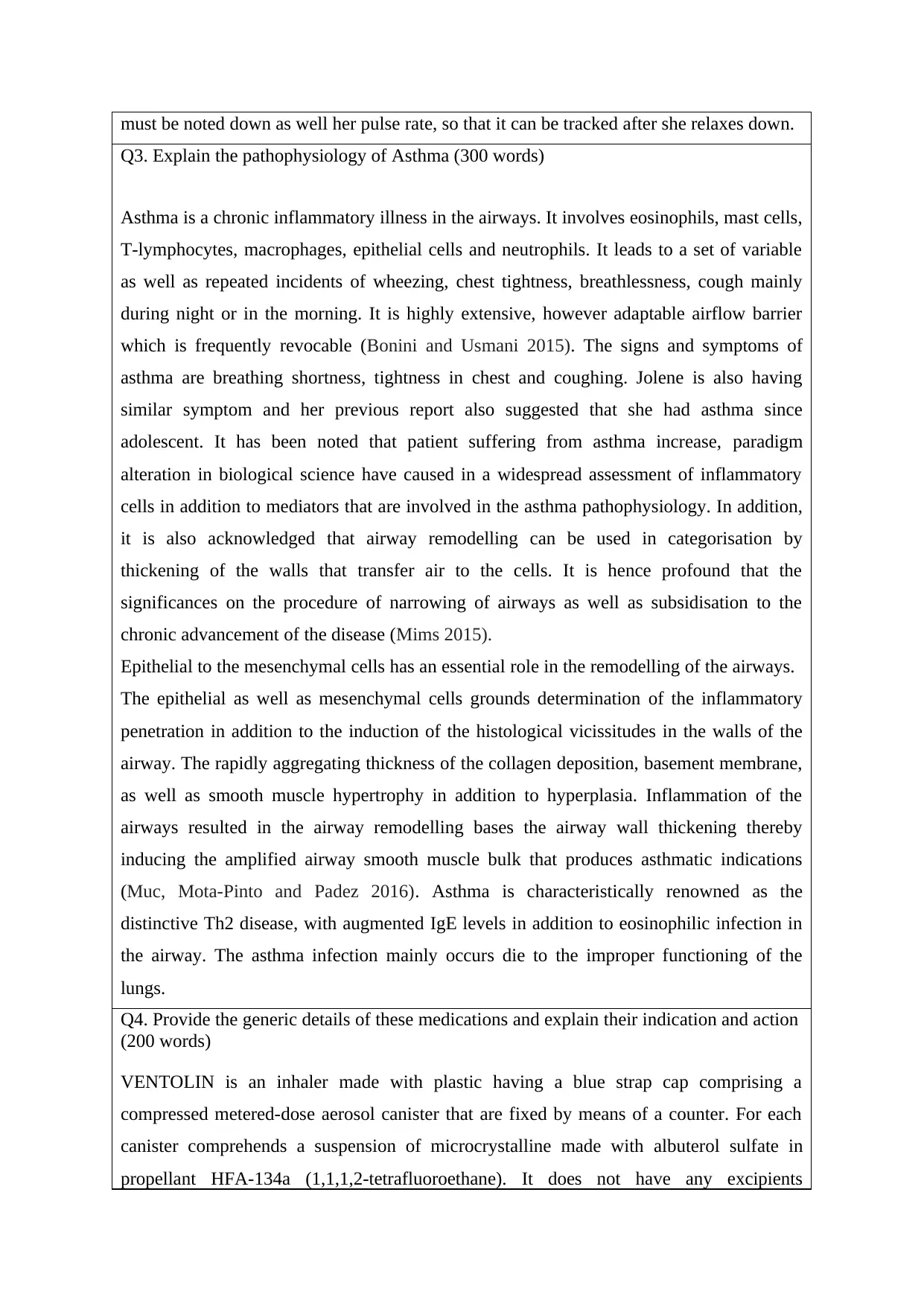
must be noted down as well her pulse rate, so that it can be tracked after she relaxes down.
Q3. Explain the pathophysiology of Asthma (300 words)
Asthma is a chronic inflammatory illness in the airways. It involves eosinophils, mast cells,
T-lymphocytes, macrophages, epithelial cells and neutrophils. It leads to a set of variable
as well as repeated incidents of wheezing, chest tightness, breathlessness, cough mainly
during night or in the morning. It is highly extensive, however adaptable airflow barrier
which is frequently revocable (Bonini and Usmani 2015). The signs and symptoms of
asthma are breathing shortness, tightness in chest and coughing. Jolene is also having
similar symptom and her previous report also suggested that she had asthma since
adolescent. It has been noted that patient suffering from asthma increase, paradigm
alteration in biological science have caused in a widespread assessment of inflammatory
cells in addition to mediators that are involved in the asthma pathophysiology. In addition,
it is also acknowledged that airway remodelling can be used in categorisation by
thickening of the walls that transfer air to the cells. It is hence profound that the
significances on the procedure of narrowing of airways as well as subsidisation to the
chronic advancement of the disease (Mims 2015).
Epithelial to the mesenchymal cells has an essential role in the remodelling of the airways.
The epithelial as well as mesenchymal cells grounds determination of the inflammatory
penetration in addition to the induction of the histological vicissitudes in the walls of the
airway. The rapidly aggregating thickness of the collagen deposition, basement membrane,
as well as smooth muscle hypertrophy in addition to hyperplasia. Inflammation of the
airways resulted in the airway remodelling bases the airway wall thickening thereby
inducing the amplified airway smooth muscle bulk that produces asthmatic indications
(Muc, Mota-Pinto and Padez 2016). Asthma is characteristically renowned as the
distinctive Th2 disease, with augmented IgE levels in addition to eosinophilic infection in
the airway. The asthma infection mainly occurs die to the improper functioning of the
lungs.
Q4. Provide the generic details of these medications and explain their indication and action
(200 words)
VENTOLIN is an inhaler made with plastic having a blue strap cap comprising a
compressed metered-dose aerosol canister that are fixed by means of a counter. For each
canister comprehends a suspension of microcrystalline made with albuterol sulfate in
propellant HFA-134a (1,1,1,2-tetrafluoroethane). It does not have any excipients
Q3. Explain the pathophysiology of Asthma (300 words)
Asthma is a chronic inflammatory illness in the airways. It involves eosinophils, mast cells,
T-lymphocytes, macrophages, epithelial cells and neutrophils. It leads to a set of variable
as well as repeated incidents of wheezing, chest tightness, breathlessness, cough mainly
during night or in the morning. It is highly extensive, however adaptable airflow barrier
which is frequently revocable (Bonini and Usmani 2015). The signs and symptoms of
asthma are breathing shortness, tightness in chest and coughing. Jolene is also having
similar symptom and her previous report also suggested that she had asthma since
adolescent. It has been noted that patient suffering from asthma increase, paradigm
alteration in biological science have caused in a widespread assessment of inflammatory
cells in addition to mediators that are involved in the asthma pathophysiology. In addition,
it is also acknowledged that airway remodelling can be used in categorisation by
thickening of the walls that transfer air to the cells. It is hence profound that the
significances on the procedure of narrowing of airways as well as subsidisation to the
chronic advancement of the disease (Mims 2015).
Epithelial to the mesenchymal cells has an essential role in the remodelling of the airways.
The epithelial as well as mesenchymal cells grounds determination of the inflammatory
penetration in addition to the induction of the histological vicissitudes in the walls of the
airway. The rapidly aggregating thickness of the collagen deposition, basement membrane,
as well as smooth muscle hypertrophy in addition to hyperplasia. Inflammation of the
airways resulted in the airway remodelling bases the airway wall thickening thereby
inducing the amplified airway smooth muscle bulk that produces asthmatic indications
(Muc, Mota-Pinto and Padez 2016). Asthma is characteristically renowned as the
distinctive Th2 disease, with augmented IgE levels in addition to eosinophilic infection in
the airway. The asthma infection mainly occurs die to the improper functioning of the
lungs.
Q4. Provide the generic details of these medications and explain their indication and action
(200 words)
VENTOLIN is an inhaler made with plastic having a blue strap cap comprising a
compressed metered-dose aerosol canister that are fixed by means of a counter. For each
canister comprehends a suspension of microcrystalline made with albuterol sulfate in
propellant HFA-134a (1,1,1,2-tetrafluoroethane). It does not have any excipients
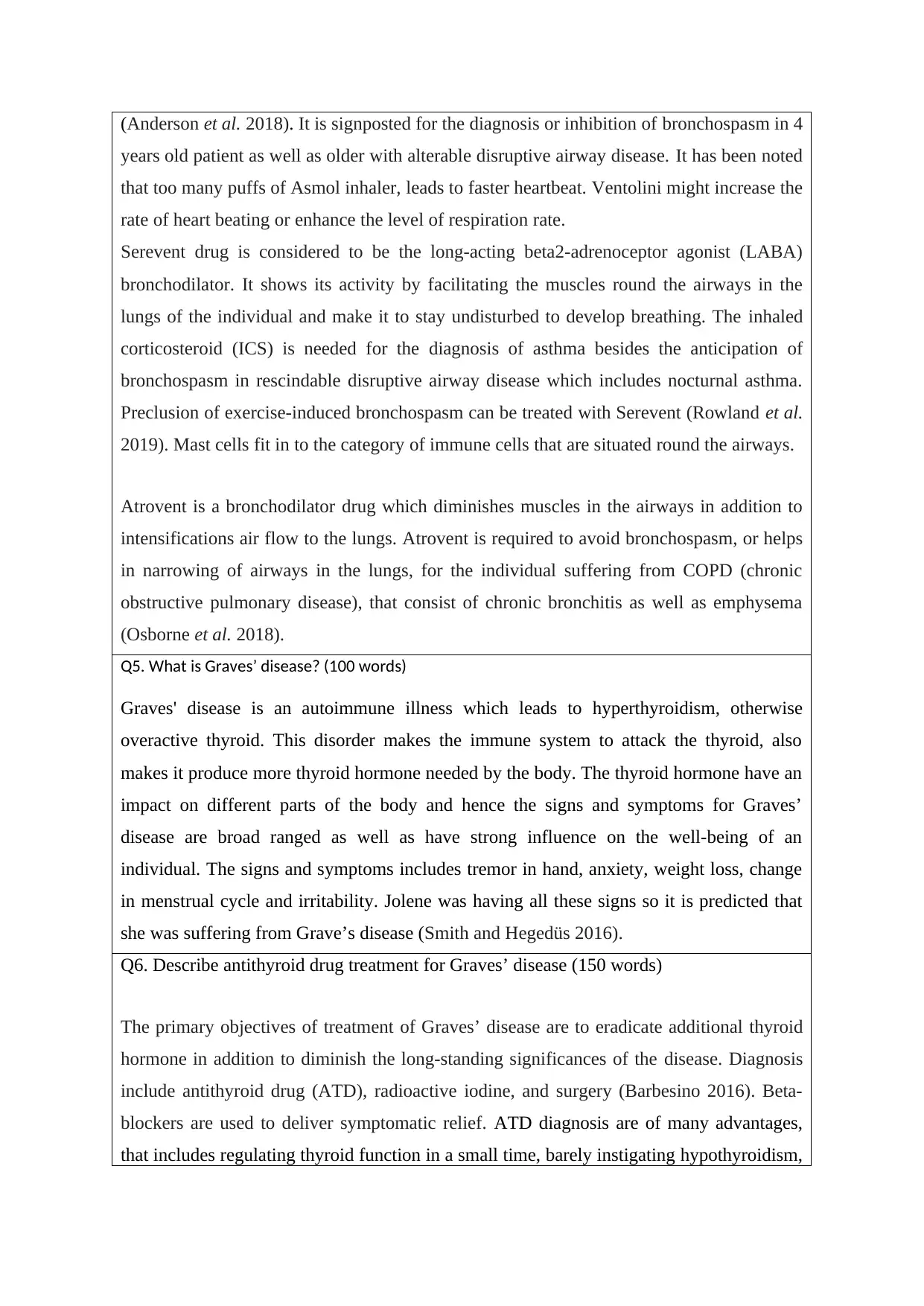
(Anderson et al. 2018). It is signposted for the diagnosis or inhibition of bronchospasm in 4
years old patient as well as older with alterable disruptive airway disease. It has been noted
that too many puffs of Asmol inhaler, leads to faster heartbeat. Ventolini might increase the
rate of heart beating or enhance the level of respiration rate.
Serevent drug is considered to be the long-acting beta2-adrenoceptor agonist (LABA)
bronchodilator. It shows its activity by facilitating the muscles round the airways in the
lungs of the individual and make it to stay undisturbed to develop breathing. The inhaled
corticosteroid (ICS) is needed for the diagnosis of asthma besides the anticipation of
bronchospasm in rescindable disruptive airway disease which includes nocturnal asthma.
Preclusion of exercise-induced bronchospasm can be treated with Serevent (Rowland et al.
2019). Mast cells fit in to the category of immune cells that are situated round the airways.
Atrovent is a bronchodilator drug which diminishes muscles in the airways in addition to
intensifications air flow to the lungs. Atrovent is required to avoid bronchospasm, or helps
in narrowing of airways in the lungs, for the individual suffering from COPD (chronic
obstructive pulmonary disease), that consist of chronic bronchitis as well as emphysema
(Osborne et al. 2018).
Q5. What is Graves’ disease? (100 words)
Graves' disease is an autoimmune illness which leads to hyperthyroidism, otherwise
overactive thyroid. This disorder makes the immune system to attack the thyroid, also
makes it produce more thyroid hormone needed by the body. The thyroid hormone have an
impact on different parts of the body and hence the signs and symptoms for Graves’
disease are broad ranged as well as have strong influence on the well-being of an
individual. The signs and symptoms includes tremor in hand, anxiety, weight loss, change
in menstrual cycle and irritability. Jolene was having all these signs so it is predicted that
she was suffering from Grave’s disease (Smith and Hegedüs 2016).
Q6. Describe antithyroid drug treatment for Graves’ disease (150 words)
The primary objectives of treatment of Graves’ disease are to eradicate additional thyroid
hormone in addition to diminish the long-standing significances of the disease. Diagnosis
include antithyroid drug (ATD), radioactive iodine, and surgery (Barbesino 2016). Beta-
blockers are used to deliver symptomatic relief. ATD diagnosis are of many advantages,
that includes regulating thyroid function in a small time, barely instigating hypothyroidism,
years old patient as well as older with alterable disruptive airway disease. It has been noted
that too many puffs of Asmol inhaler, leads to faster heartbeat. Ventolini might increase the
rate of heart beating or enhance the level of respiration rate.
Serevent drug is considered to be the long-acting beta2-adrenoceptor agonist (LABA)
bronchodilator. It shows its activity by facilitating the muscles round the airways in the
lungs of the individual and make it to stay undisturbed to develop breathing. The inhaled
corticosteroid (ICS) is needed for the diagnosis of asthma besides the anticipation of
bronchospasm in rescindable disruptive airway disease which includes nocturnal asthma.
Preclusion of exercise-induced bronchospasm can be treated with Serevent (Rowland et al.
2019). Mast cells fit in to the category of immune cells that are situated round the airways.
Atrovent is a bronchodilator drug which diminishes muscles in the airways in addition to
intensifications air flow to the lungs. Atrovent is required to avoid bronchospasm, or helps
in narrowing of airways in the lungs, for the individual suffering from COPD (chronic
obstructive pulmonary disease), that consist of chronic bronchitis as well as emphysema
(Osborne et al. 2018).
Q5. What is Graves’ disease? (100 words)
Graves' disease is an autoimmune illness which leads to hyperthyroidism, otherwise
overactive thyroid. This disorder makes the immune system to attack the thyroid, also
makes it produce more thyroid hormone needed by the body. The thyroid hormone have an
impact on different parts of the body and hence the signs and symptoms for Graves’
disease are broad ranged as well as have strong influence on the well-being of an
individual. The signs and symptoms includes tremor in hand, anxiety, weight loss, change
in menstrual cycle and irritability. Jolene was having all these signs so it is predicted that
she was suffering from Grave’s disease (Smith and Hegedüs 2016).
Q6. Describe antithyroid drug treatment for Graves’ disease (150 words)
The primary objectives of treatment of Graves’ disease are to eradicate additional thyroid
hormone in addition to diminish the long-standing significances of the disease. Diagnosis
include antithyroid drug (ATD), radioactive iodine, and surgery (Barbesino 2016). Beta-
blockers are used to deliver symptomatic relief. ATD diagnosis are of many advantages,
that includes regulating thyroid function in a small time, barely instigating hypothyroidism,
⊘ This is a preview!⊘
Do you want full access?
Subscribe today to unlock all pages.

Trusted by 1+ million students worldwide
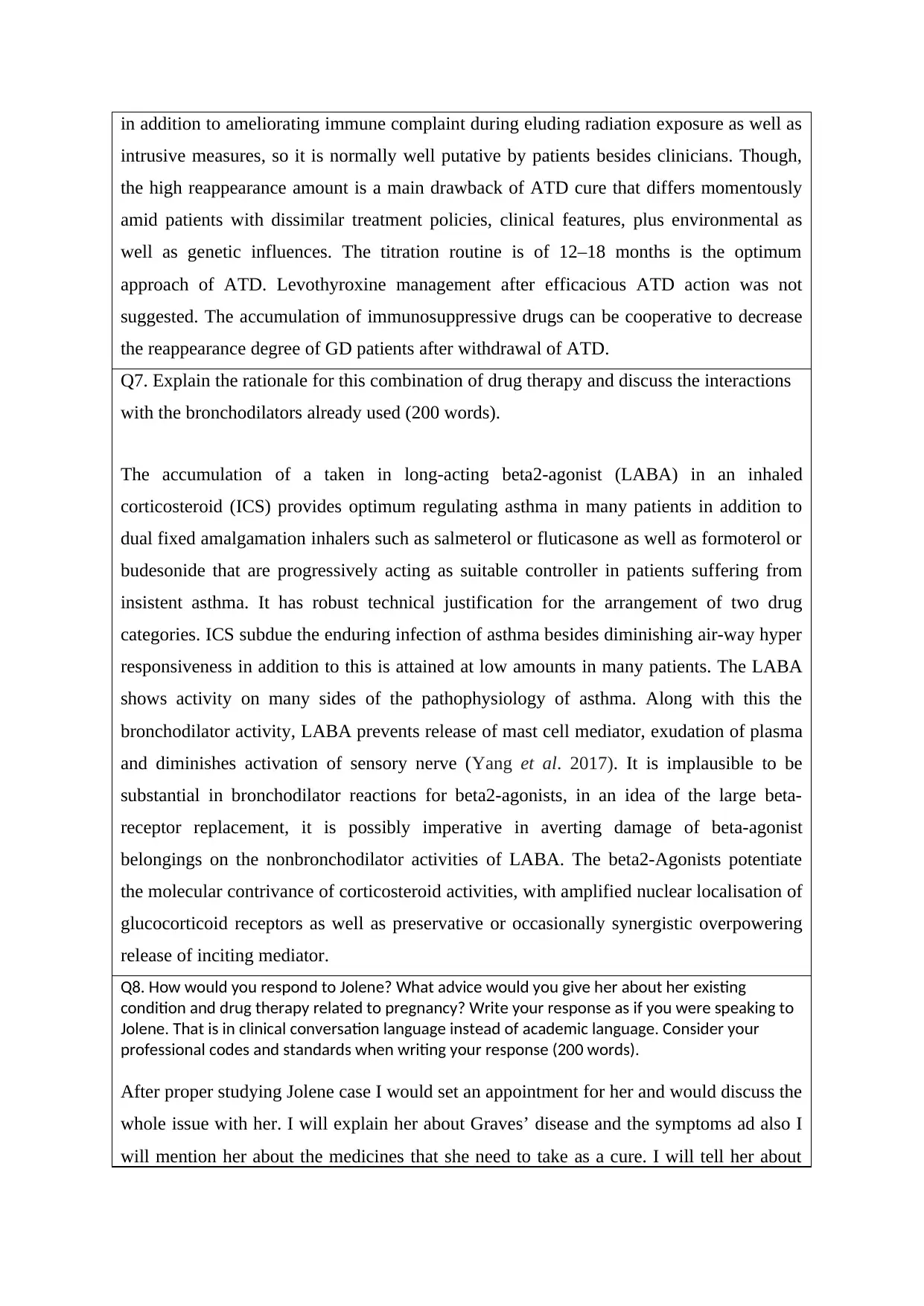
in addition to ameliorating immune complaint during eluding radiation exposure as well as
intrusive measures, so it is normally well putative by patients besides clinicians. Though,
the high reappearance amount is a main drawback of ATD cure that differs momentously
amid patients with dissimilar treatment policies, clinical features, plus environmental as
well as genetic influences. The titration routine is of 12–18 months is the optimum
approach of ATD. Levothyroxine management after efficacious ATD action was not
suggested. The accumulation of immunosuppressive drugs can be cooperative to decrease
the reappearance degree of GD patients after withdrawal of ATD.
Q7. Explain the rationale for this combination of drug therapy and discuss the interactions
with the bronchodilators already used (200 words).
The accumulation of a taken in long-acting beta2-agonist (LABA) in an inhaled
corticosteroid (ICS) provides optimum regulating asthma in many patients in addition to
dual fixed amalgamation inhalers such as salmeterol or fluticasone as well as formoterol or
budesonide that are progressively acting as suitable controller in patients suffering from
insistent asthma. It has robust technical justification for the arrangement of two drug
categories. ICS subdue the enduring infection of asthma besides diminishing air-way hyper
responsiveness in addition to this is attained at low amounts in many patients. The LABA
shows activity on many sides of the pathophysiology of asthma. Along with this the
bronchodilator activity, LABA prevents release of mast cell mediator, exudation of plasma
and diminishes activation of sensory nerve (Yang et al. 2017). It is implausible to be
substantial in bronchodilator reactions for beta2-agonists, in an idea of the large beta-
receptor replacement, it is possibly imperative in averting damage of beta-agonist
belongings on the nonbronchodilator activities of LABA. The beta2-Agonists potentiate
the molecular contrivance of corticosteroid activities, with amplified nuclear localisation of
glucocorticoid receptors as well as preservative or occasionally synergistic overpowering
release of inciting mediator.
Q8. How would you respond to Jolene? What advice would you give her about her existing
condition and drug therapy related to pregnancy? Write your response as if you were speaking to
Jolene. That is in clinical conversation language instead of academic language. Consider your
professional codes and standards when writing your response (200 words).
After proper studying Jolene case I would set an appointment for her and would discuss the
whole issue with her. I will explain her about Graves’ disease and the symptoms ad also I
will mention her about the medicines that she need to take as a cure. I will tell her about
intrusive measures, so it is normally well putative by patients besides clinicians. Though,
the high reappearance amount is a main drawback of ATD cure that differs momentously
amid patients with dissimilar treatment policies, clinical features, plus environmental as
well as genetic influences. The titration routine is of 12–18 months is the optimum
approach of ATD. Levothyroxine management after efficacious ATD action was not
suggested. The accumulation of immunosuppressive drugs can be cooperative to decrease
the reappearance degree of GD patients after withdrawal of ATD.
Q7. Explain the rationale for this combination of drug therapy and discuss the interactions
with the bronchodilators already used (200 words).
The accumulation of a taken in long-acting beta2-agonist (LABA) in an inhaled
corticosteroid (ICS) provides optimum regulating asthma in many patients in addition to
dual fixed amalgamation inhalers such as salmeterol or fluticasone as well as formoterol or
budesonide that are progressively acting as suitable controller in patients suffering from
insistent asthma. It has robust technical justification for the arrangement of two drug
categories. ICS subdue the enduring infection of asthma besides diminishing air-way hyper
responsiveness in addition to this is attained at low amounts in many patients. The LABA
shows activity on many sides of the pathophysiology of asthma. Along with this the
bronchodilator activity, LABA prevents release of mast cell mediator, exudation of plasma
and diminishes activation of sensory nerve (Yang et al. 2017). It is implausible to be
substantial in bronchodilator reactions for beta2-agonists, in an idea of the large beta-
receptor replacement, it is possibly imperative in averting damage of beta-agonist
belongings on the nonbronchodilator activities of LABA. The beta2-Agonists potentiate
the molecular contrivance of corticosteroid activities, with amplified nuclear localisation of
glucocorticoid receptors as well as preservative or occasionally synergistic overpowering
release of inciting mediator.
Q8. How would you respond to Jolene? What advice would you give her about her existing
condition and drug therapy related to pregnancy? Write your response as if you were speaking to
Jolene. That is in clinical conversation language instead of academic language. Consider your
professional codes and standards when writing your response (200 words).
After proper studying Jolene case I would set an appointment for her and would discuss the
whole issue with her. I will explain her about Graves’ disease and the symptoms ad also I
will mention her about the medicines that she need to take as a cure. I will tell her about
Paraphrase This Document
Need a fresh take? Get an instant paraphrase of this document with our AI Paraphraser
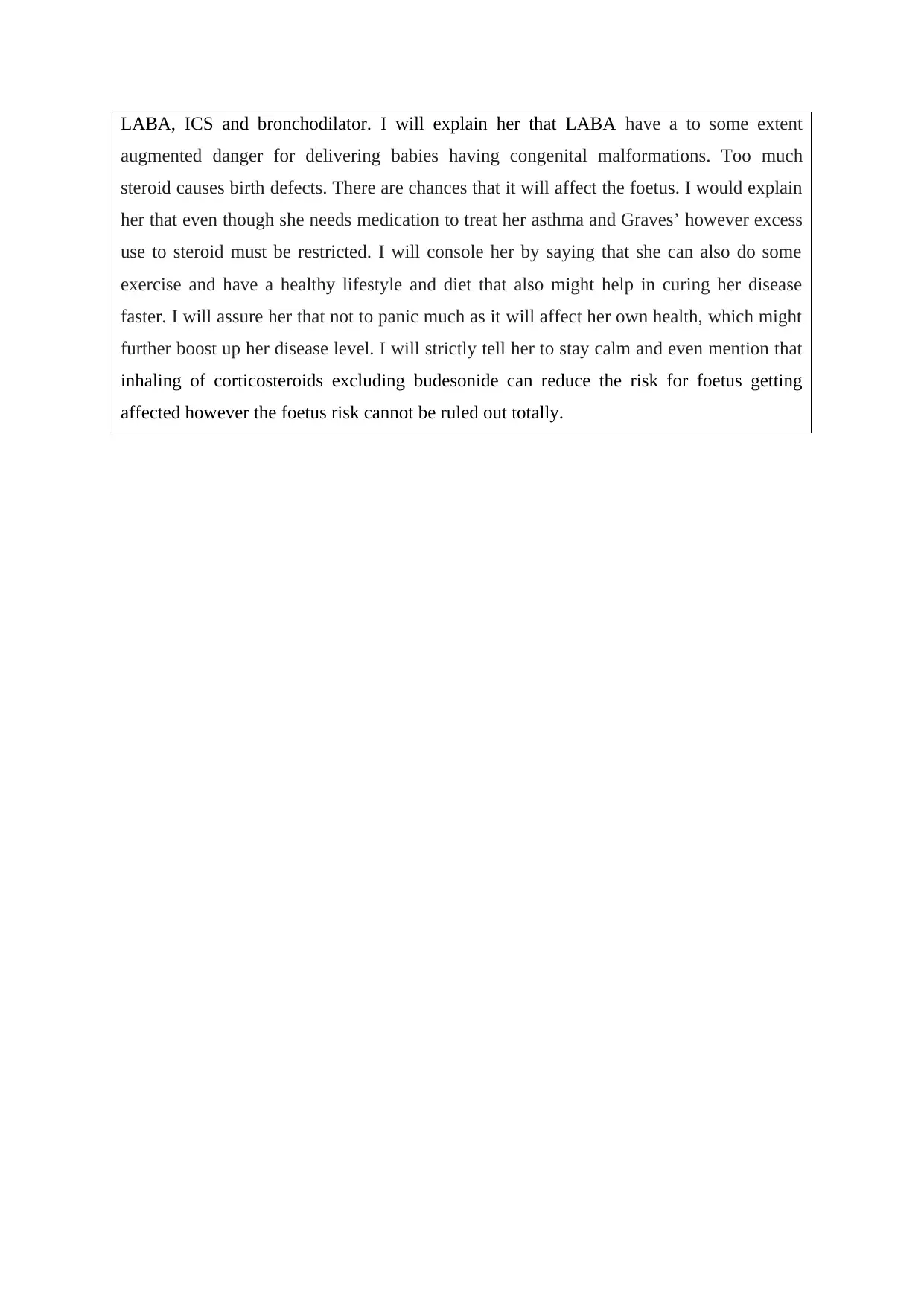
LABA, ICS and bronchodilator. I will explain her that LABA have a to some extent
augmented danger for delivering babies having congenital malformations. Too much
steroid causes birth defects. There are chances that it will affect the foetus. I would explain
her that even though she needs medication to treat her asthma and Graves’ however excess
use to steroid must be restricted. I will console her by saying that she can also do some
exercise and have a healthy lifestyle and diet that also might help in curing her disease
faster. I will assure her that not to panic much as it will affect her own health, which might
further boost up her disease level. I will strictly tell her to stay calm and even mention that
inhaling of corticosteroids excluding budesonide can reduce the risk for foetus getting
affected however the foetus risk cannot be ruled out totally.
augmented danger for delivering babies having congenital malformations. Too much
steroid causes birth defects. There are chances that it will affect the foetus. I would explain
her that even though she needs medication to treat her asthma and Graves’ however excess
use to steroid must be restricted. I will console her by saying that she can also do some
exercise and have a healthy lifestyle and diet that also might help in curing her disease
faster. I will assure her that not to panic much as it will affect her own health, which might
further boost up her disease level. I will strictly tell her to stay calm and even mention that
inhaling of corticosteroids excluding budesonide can reduce the risk for foetus getting
affected however the foetus risk cannot be ruled out totally.
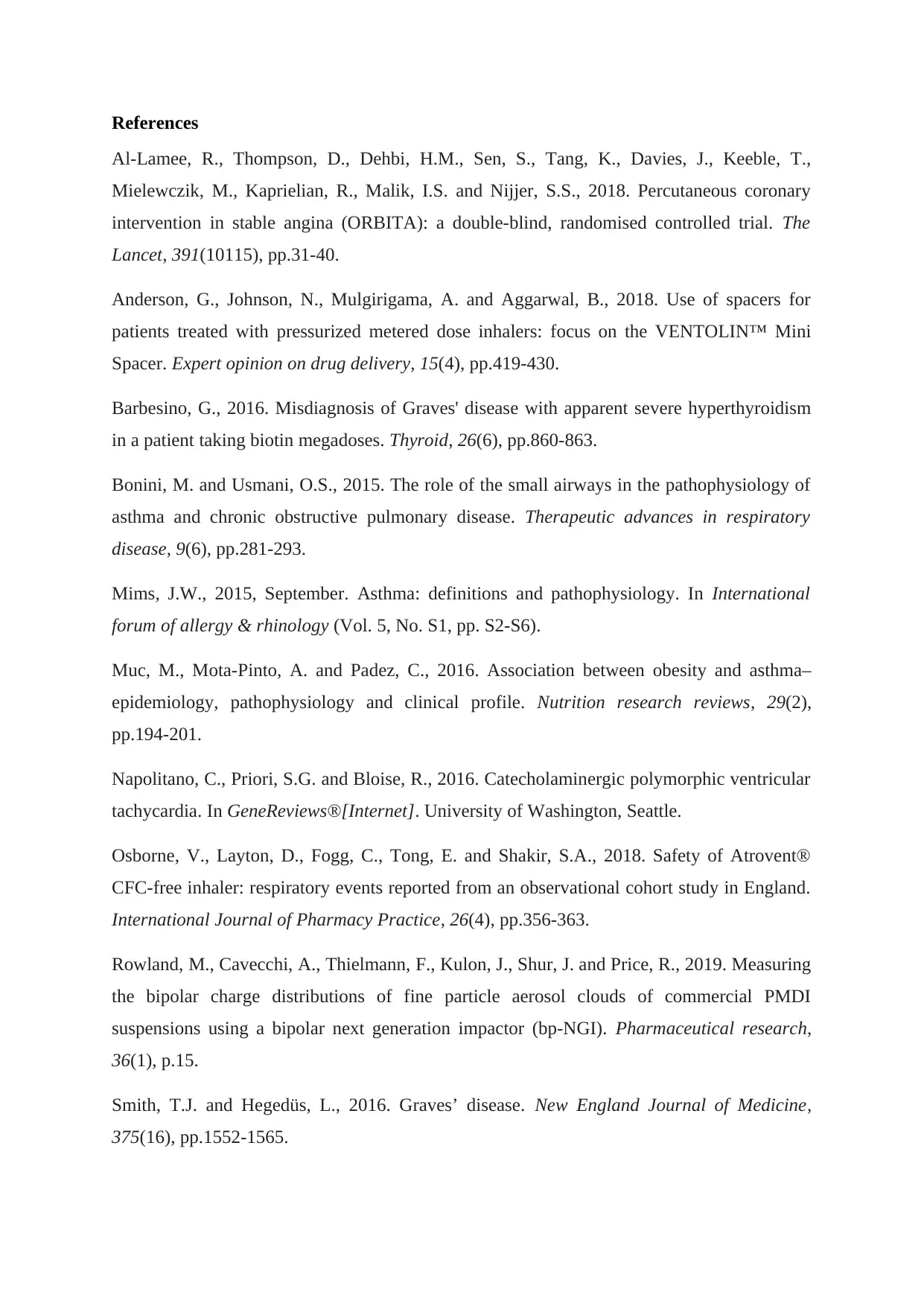
References
Al-Lamee, R., Thompson, D., Dehbi, H.M., Sen, S., Tang, K., Davies, J., Keeble, T.,
Mielewczik, M., Kaprielian, R., Malik, I.S. and Nijjer, S.S., 2018. Percutaneous coronary
intervention in stable angina (ORBITA): a double-blind, randomised controlled trial. The
Lancet, 391(10115), pp.31-40.
Anderson, G., Johnson, N., Mulgirigama, A. and Aggarwal, B., 2018. Use of spacers for
patients treated with pressurized metered dose inhalers: focus on the VENTOLIN™ Mini
Spacer. Expert opinion on drug delivery, 15(4), pp.419-430.
Barbesino, G., 2016. Misdiagnosis of Graves' disease with apparent severe hyperthyroidism
in a patient taking biotin megadoses. Thyroid, 26(6), pp.860-863.
Bonini, M. and Usmani, O.S., 2015. The role of the small airways in the pathophysiology of
asthma and chronic obstructive pulmonary disease. Therapeutic advances in respiratory
disease, 9(6), pp.281-293.
Mims, J.W., 2015, September. Asthma: definitions and pathophysiology. In International
forum of allergy & rhinology (Vol. 5, No. S1, pp. S2-S6).
Muc, M., Mota-Pinto, A. and Padez, C., 2016. Association between obesity and asthma–
epidemiology, pathophysiology and clinical profile. Nutrition research reviews, 29(2),
pp.194-201.
Napolitano, C., Priori, S.G. and Bloise, R., 2016. Catecholaminergic polymorphic ventricular
tachycardia. In GeneReviews®[Internet]. University of Washington, Seattle.
Osborne, V., Layton, D., Fogg, C., Tong, E. and Shakir, S.A., 2018. Safety of Atrovent®
CFC‐free inhaler: respiratory events reported from an observational cohort study in England.
International Journal of Pharmacy Practice, 26(4), pp.356-363.
Rowland, M., Cavecchi, A., Thielmann, F., Kulon, J., Shur, J. and Price, R., 2019. Measuring
the bipolar charge distributions of fine particle aerosol clouds of commercial PMDI
suspensions using a bipolar next generation impactor (bp-NGI). Pharmaceutical research,
36(1), p.15.
Smith, T.J. and Hegedüs, L., 2016. Graves’ disease. New England Journal of Medicine,
375(16), pp.1552-1565.
Al-Lamee, R., Thompson, D., Dehbi, H.M., Sen, S., Tang, K., Davies, J., Keeble, T.,
Mielewczik, M., Kaprielian, R., Malik, I.S. and Nijjer, S.S., 2018. Percutaneous coronary
intervention in stable angina (ORBITA): a double-blind, randomised controlled trial. The
Lancet, 391(10115), pp.31-40.
Anderson, G., Johnson, N., Mulgirigama, A. and Aggarwal, B., 2018. Use of spacers for
patients treated with pressurized metered dose inhalers: focus on the VENTOLIN™ Mini
Spacer. Expert opinion on drug delivery, 15(4), pp.419-430.
Barbesino, G., 2016. Misdiagnosis of Graves' disease with apparent severe hyperthyroidism
in a patient taking biotin megadoses. Thyroid, 26(6), pp.860-863.
Bonini, M. and Usmani, O.S., 2015. The role of the small airways in the pathophysiology of
asthma and chronic obstructive pulmonary disease. Therapeutic advances in respiratory
disease, 9(6), pp.281-293.
Mims, J.W., 2015, September. Asthma: definitions and pathophysiology. In International
forum of allergy & rhinology (Vol. 5, No. S1, pp. S2-S6).
Muc, M., Mota-Pinto, A. and Padez, C., 2016. Association between obesity and asthma–
epidemiology, pathophysiology and clinical profile. Nutrition research reviews, 29(2),
pp.194-201.
Napolitano, C., Priori, S.G. and Bloise, R., 2016. Catecholaminergic polymorphic ventricular
tachycardia. In GeneReviews®[Internet]. University of Washington, Seattle.
Osborne, V., Layton, D., Fogg, C., Tong, E. and Shakir, S.A., 2018. Safety of Atrovent®
CFC‐free inhaler: respiratory events reported from an observational cohort study in England.
International Journal of Pharmacy Practice, 26(4), pp.356-363.
Rowland, M., Cavecchi, A., Thielmann, F., Kulon, J., Shur, J. and Price, R., 2019. Measuring
the bipolar charge distributions of fine particle aerosol clouds of commercial PMDI
suspensions using a bipolar next generation impactor (bp-NGI). Pharmaceutical research,
36(1), p.15.
Smith, T.J. and Hegedüs, L., 2016. Graves’ disease. New England Journal of Medicine,
375(16), pp.1552-1565.
⊘ This is a preview!⊘
Do you want full access?
Subscribe today to unlock all pages.

Trusted by 1+ million students worldwide
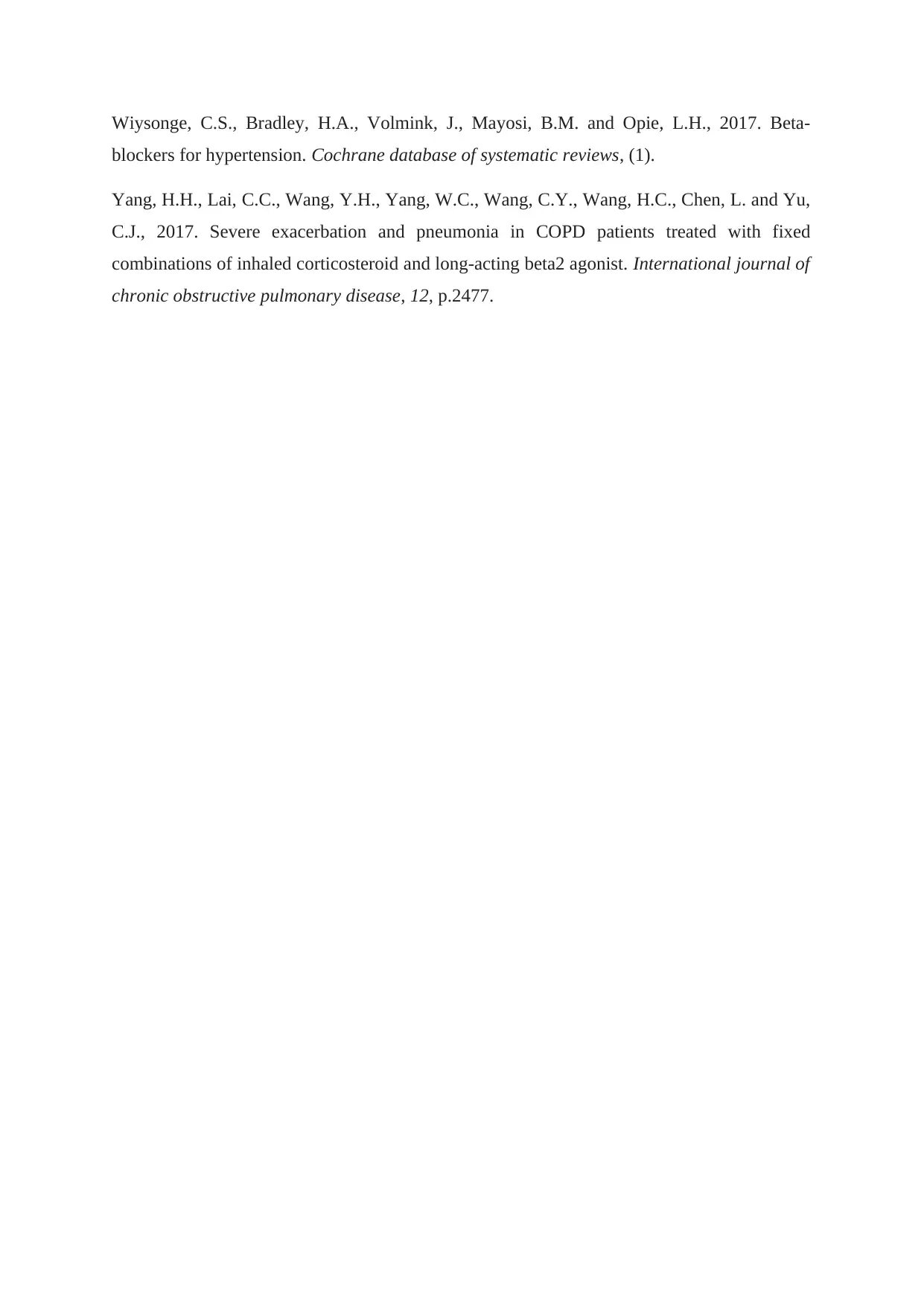
Wiysonge, C.S., Bradley, H.A., Volmink, J., Mayosi, B.M. and Opie, L.H., 2017. Beta‐
blockers for hypertension. Cochrane database of systematic reviews, (1).
Yang, H.H., Lai, C.C., Wang, Y.H., Yang, W.C., Wang, C.Y., Wang, H.C., Chen, L. and Yu,
C.J., 2017. Severe exacerbation and pneumonia in COPD patients treated with fixed
combinations of inhaled corticosteroid and long-acting beta2 agonist. International journal of
chronic obstructive pulmonary disease, 12, p.2477.
blockers for hypertension. Cochrane database of systematic reviews, (1).
Yang, H.H., Lai, C.C., Wang, Y.H., Yang, W.C., Wang, C.Y., Wang, H.C., Chen, L. and Yu,
C.J., 2017. Severe exacerbation and pneumonia in COPD patients treated with fixed
combinations of inhaled corticosteroid and long-acting beta2 agonist. International journal of
chronic obstructive pulmonary disease, 12, p.2477.
1 out of 7
Related Documents
Your All-in-One AI-Powered Toolkit for Academic Success.
+13062052269
info@desklib.com
Available 24*7 on WhatsApp / Email
![[object Object]](/_next/static/media/star-bottom.7253800d.svg)
Unlock your academic potential
Copyright © 2020–2025 A2Z Services. All Rights Reserved. Developed and managed by ZUCOL.





